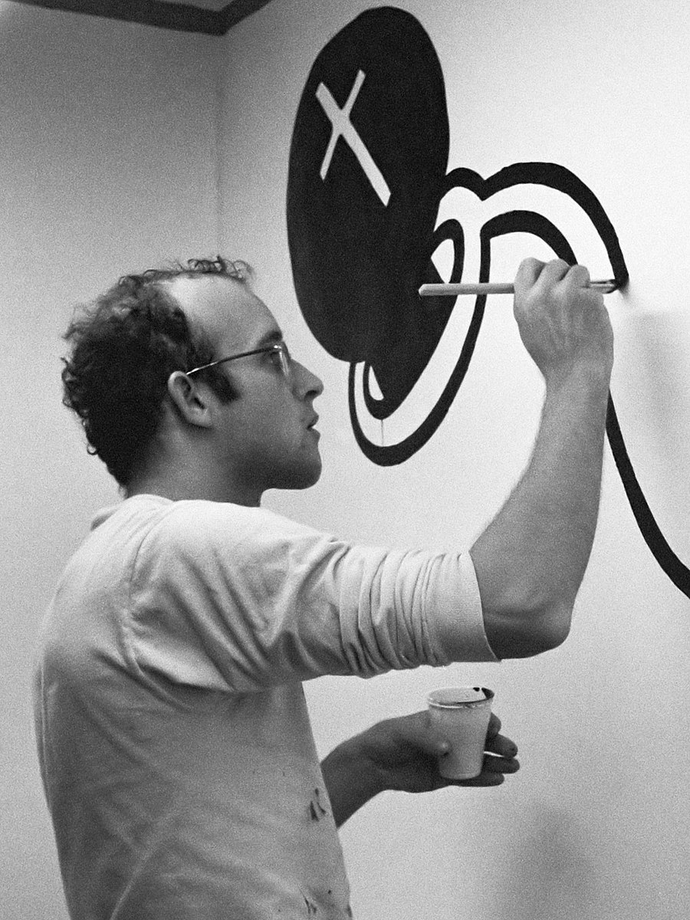
Keith Haring
Keith Haring was an American artist known for his distinctive style of graffiti-inspired art that emerged in New York City in the 1980s.
Biography of Keith Haring
Keith Haring was born in 1958 in Reading, Pennsylvania, and grew up in nearby Kutztown, Pennsylvania. He developed a passion for drawing early on, learning cartooning skills from his father and figures like Dr. Seuss and Walt Disney. After graduating from high school in 1976, Haring attended the Ivy School of Professional Art in Pittsburgh but dropped out after two semesters as he realized his lack of interest in commercial graphic art. During his time in Pittsburgh, he continued to hone his skills, leading to a solo exhibition of his work at the Pittsburgh Arts and Crafts Center in 1978.
Later that same year, Haring relocated to New York City and enrolled at the School of Visual Arts (SVA). In New York, he discovered a vibrant alternative art community emerging outside traditional galleries and museums, in the streets, subways, and spaces of clubs and former dance halls. There, he formed friendships with fellow artists Kenny Scharf and Jean-Michel Basquiat, as well as musicians, performance artists, and graffiti writers who were part of this growing art scene.
Throughout the early 1980s, Haring undertook a variety of public projects, showcasing his diverse talents. These included creating an animation for the Spectacolor billboard in Times Square, designing sets and backdrops for theaters and clubs, developing watch designs for Swatch, launching an advertising campaign for Absolut vodka, and painting murals across the globe.
Between 1980 and 1989, Keith Haring gained international acclaim through numerous group and solo exhibitions. His inaugural solo exhibition in New York took place at the Westbeth Painters Space in 1981. The following year, he captivated audiences with a popular and highly praised solo show at the Tony Shafrazi Gallery in Soho. Amidst this success, Haring also participated in prestigious international exhibitions such as Documenta 7 in Kassel, the São Paulo Biennial, and the Whitney Biennial.
In April 1986, Keith Haring launched the Pop Shop, a retail establishment in Soho where T-shirts, toys, posters, buttons, and magnets featuring his artwork were sold. Haring viewed the shop as an extension of his artistic vision, he painted the entire interior with an abstract black-on-white mural, creating a visually striking and distinctive retail space. The Pop Shop aimed to make his artwork more accessible to the public, offering his creations on various products at affordable prices.
Throughout his career, Keith Haring dedicated a significant amount of time to creating public artworks with social messages. Between 1982 and 1989, he completed over 50 public art pieces in numerous cities worldwide. One of his most iconic works, the "Crack is Wack" mural from 1986, has become a well-known landmark along New York's FDR Drive.
Among his notable projects, Haring collaborated with 900 children on a mural commemorating the 100th anniversary of the Statue of Liberty in 1986. Additionally, Haring conducted drawing workshops for children in schools and museums across cities such as New York, Amsterdam, London, Tokyo, and Bordeaux. He contributed artwork to various literacy programs and other public service campaigns, using his art as a tool for education and social awareness.
In 1988, Keith Haring received a diagnosis of AIDS. The following year, in 1989, he founded the Keith Haring Foundation intending to support AIDS organizations, and children's programs, and broaden the reach of his artwork through exhibitions, publications, and licensing of his images. During the final years of his life, Haring utilized his art to speak about his illness, using his imagery as a means to promote activism and raise awareness about AIDS.
Keith Haring passed away from complications related to AIDS at the age of 31 on February 16, 1990. Following his death, Keith Haring has been honored with numerous international retrospectives. Today, his artwork is prominently featured in exhibitions and collections of major museums worldwide.
Keith Haring's Art Style
Impressed by the innovation and vitality of his peers, Keith Haring drew inspiration from a variety of artists including Jean Dubuffet, Pierre Alechinsky, William Burroughs, Brion Gysin, and Robert Henri's manifesto "The Art Spirit," which emphasized the artist's essential independence. These influences allowed Haring to channel his youthful impulses into a distinctive graphic style centered on the importance of the line. Additionally, he was captivated by the public and participatory aspects of Christo's work, particularly "Running Fence," and by Andy Warhol's seamless blend of art and life. With these inspirations, Haring was resolute in dedicating his career to the creation of truly public art.
While a student at SVA, Haring explored various forms of art, including performance, video, installation, and collage, all while maintaining a steadfast dedication to drawing. In 1980, he discovered a powerful medium for reaching the broader audience he sought after noticing unused advertising panels covered in matte black paper in a subway station. Using white chalk, Haring began creating drawings on these blank paper panels throughout the subway system.
Between 1980 and 1985, Haring produced hundreds of these public drawings with rapid, rhythmic lines, sometimes completing as many as forty "subway drawings" in a single day. New York commuters became familiar with this continuous flow of images, often stopping to interact with the artist as he worked. The subway, as Haring described it, became a "laboratory" for developing his ideas and experimenting with his signature simple lines.
By exploring universal themes such as birth, death, love, sex, and war with a distinctive use of line and straightforward messages, Haring attracted a broad audience. His imagery, characterized by its accessibility and enduring impact, has evolved into a universally recognized visual language of the 20th century.
Years:
Born in 1958
Country:
United States of America, Reading
Gallery: